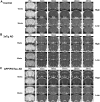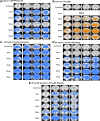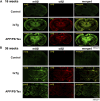Oligomeric amyloid-β targeted contrast agent for MRI evaluation of Alzheimer's disease mouse models
- PMID: 38895620
- PMCID: PMC11184063
- DOI: 10.3389/fphar.2024.1392729
Oligomeric amyloid-β targeted contrast agent for MRI evaluation of Alzheimer's disease mouse models
Abstract
Background: Oligomeric amyloid beta (oAβ) is a toxic factor that acts in the early stage of Alzheimer's disease (AD) and may initiate the pathologic cascade. Therefore, detecting oAβ has a crucial role in the early diagnosis, monitoring, and treatment of AD.
Purpose: The purpose of this study was to evaluate MRI signal changes in different mouse models and the time-dependent signal changes using our novel gadolinium (Gd)-dodecane tetraacetic acid (DOTA)- ob5 aptamer contrast agent.
Methods: We developed an MRI contrast agent by conjugating Gd-DOTA-DNA aptamer called ob5 to evaluate its ability to detect oAβ deposits in the brain using MRI. A total of 10 control mice, 9 3xTg AD mice, and 11 APP/PS/Tau AD mice were included in this study, with the age of each model being 16 or 36 weeks. A T1-weighted image was acquired at the time points before (0 min) and after injection of the contrast agent at 5, 10, 15, 20, and 25 min. The analyses were performed to compare MRI signal differences among the three groups and the time-dependent signal differences in different mouse models.
Results: Both 3xTg AD and APP/PS/Tau AD mouse models had higher signal enhancement than control mice at all scan-time points after injection of our contrast media, especially in bilateral hippocampal areas. In particular, all Tg AD mouse models aged 16 weeks showed a higher contrast enhancement than those aged 36 weeks. For 3xTg AD and APP/PS/Tau AD groups, the signal enhancement was significantly different among the five time points (0 min, 5 min, 10 min, 15 min, 20 min, and 25 min) in multiple ROI areas, typically in the bilateral hippocampus, left thalamus, and left amygdala.
Conclusion: The findings of this study suggest that the expression of the contrast agent in different AD models demonstrates its translational flexibility across different species. The signal enhancement peaked around 15-20 min after injection of the contrast agent. Therefore, our novel contrast agent targeting oAβ has the potential ability to diagnose early AD and monitor the progression of AD.
Keywords: ApoE mouse model; DNA aptamer; MRI contrast agent; oligomeric amyloid-beta; tau mouse model; time-dependent signal enhancement.
Copyright © 2024 Park, Tian, Kim, Park, Kim, Chung, Kim and Jahng.
Conflict of interest statement
S-TK and YK were employed by the J&Pharma. The remaining authors declare that the research was conducted in the absence of any commercial or financial relationships that could be construed as a potential conflict of interest.
Figures








Similar articles
-
An aptamer-based magnetic resonance imaging contrast agent for detecting oligomeric amyloid-β in the brain of an Alzheimer's disease mouse model.NMR Biomed. 2023 Mar;36(3):e4862. doi: 10.1002/nbm.4862. Epub 2022 Nov 20. NMR Biomed. 2023. PMID: 36308279
-
Brain microstructure abnormalities in the 3xTg-AD mouse - A diffusion MRI and morphology correlation study.Magn Reson Imaging. 2022 Dec;94:48-55. doi: 10.1016/j.mri.2022.09.002. Epub 2022 Sep 16. Magn Reson Imaging. 2022. PMID: 36116712 Free PMC article.
-
Ultrasound with microbubbles improves memory, ameliorates pathology and modulates hippocampal proteomic changes in a triple transgenic mouse model of Alzheimer's disease.Theranostics. 2020 Sep 26;10(25):11794-11819. doi: 10.7150/thno.44152. eCollection 2020. Theranostics. 2020. PMID: 33052247 Free PMC article.
-
Key Peptides and Proteins in Alzheimer's Disease.Curr Protein Pept Sci. 2019;20(6):577-599. doi: 10.2174/1389203720666190103123434. Curr Protein Pept Sci. 2019. PMID: 30605056 Review.
-
Effects of CX3CR1 and Fractalkine Chemokines in Amyloid Beta Clearance and p-Tau Accumulation in Alzheimer's Disease (AD) Rodent Models: Is Fractalkine a Systemic Biomarker for AD?Curr Alzheimer Res. 2016;13(4):403-12. doi: 10.2174/1567205013666151116125714. Curr Alzheimer Res. 2016. PMID: 26567742 Review.
References
LinkOut - more resources
Full Text Sources
Miscellaneous

